EXCLUSIVE ARTICLE |
||
|
||
EXCLUSIVE ARTICLE |
||
|
||
|
|
|||||||||||
|
|
|||||||||||
|
In the days before the multiplex cinema and the ability to watch the James Bond series in your own home, each new 007 adventure usually opened in London's West End before transferring to the provinces and a wider general release. From 1962 to 1983 (with a few exceptions) each new film in the series had premiered at either the London Pavilion cinema on Piccadilly Circus, or the ODEON Leicester Square. The London Pavilion had been operated by film distributor United Artists as their flagship venue since 1934, and eventually closed as a cinema in April 1981. Although the ODEON Leicester Square subsequently played each film in the series after Octopussy in 1983, it was not always the venue chosen for the World Premiere of the film. Several films in the series first opened in the USA, and more recent films have premiered at The Royal Albert Hall before transferring to the ODEON Leicester Square for their main London engagement. Only Die Another Day (2002) did not initially play at the ODEON Leicester Square, instead spending six weeks at the ODEON Marble Arch following its Premiere at the Royal Albert Hall as the 2002 Royal Film Performance. The film later played at the ODEON Mezzanine (part of the ODEON Leicester Square complex) for nine weeks from January to March 2003. |
|||||||||||
|
|||||||||||
|
The 1980s brought wider release patterns and the production of more 35mm prints, so it was usually possible to see a new film in the provinces at the same time as its London engagement. Since the advent of digital cinema the need for prints of any kind was removed and the identical image can now be seen at multiple venues simultaneously. The days of a spliced, faded, jerky print was gone, and all films now took on a uniform look which was then replicated for their home cinema release. But before we reach the era of the pixel, let us take a journey back to the time when Roger Moore's swansong as 007 conquered the UK box office, and when it was still only a two-year wait to see the next film in the series. |
|||||||||||
|
“Has James Bond Finally Met His Match?” |
|||||||||||
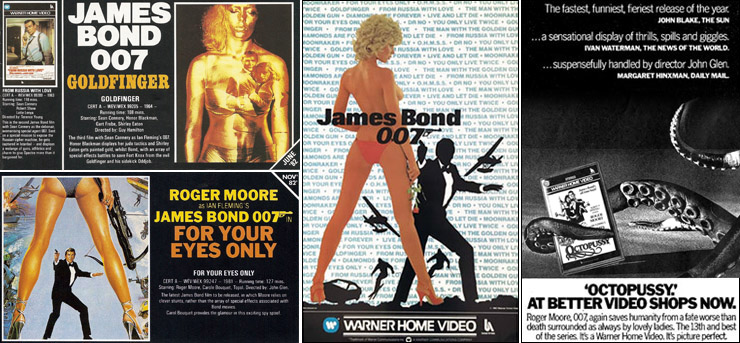 |
|||||||||||
|
The early 1980s had seen the boom in videotape rental in the UK, and in June 1982 From Russia With Love and Goldfinger were the first two James Bond films issued on VHS and Betamax by Warner Home Video. By September 1984 all films up to and including Octopussy were available to rent from your local video store and played in the comfort of your own home. Although the videos were panned & scanned editions of the films and inferior in quality to actual broadcast television, copies were so widely available and at modest cost, the home video market finally began to make a significant dent in cinema box-office takings in the ensuing decade. With Roger Moore firmly established as James Bond, many viewers were now seeing the Sean Connery films for the first time and re-evaluating his tenure as 007. Television screenings of the James Bond films on ITV became more frequent, and in October 1984 when Octopussy premiered on The Movie Channel (a cable subscription service operated by Rediffusion) this was the first network to broadcast an EON Productions Bond film other than ITV who had held the UK rights since 1975. With multiple screenings across the month at different times, this is still the model operated by satellite channels to this day. Octopussy did not have its terrestrial TV premiere on the ITV network until January 1988. |
|||||||||||
 |
|||||||||||
|
UK cinema attendance had fallen dramatically in the early 1980s, and dropped to an all-time low in 1984 with just 54-million admissions for the year. Television, and later the wider availability of videotapes, was blamed for the rapid decline. From the post-war boom of 1.6-billion admissions in over 4,500 cinemas in 1946, this had dropped to around 700 venues with a total of 1,200 screens by 1985. Although this was the time of the summer blockbuster, when one film dominated the cinematic landscape across the country for a few months, the James Bond films found it harder to compete with US releases. Although hugely successful, the release of Octopussy in 1983 fell way short of the spectacular box-office takings of Return Of The Jedi, the then final instalment in the Star Wars series. In order to compete with the home entertainment market, 1985 was designated ‘British Film Year’ by the British Film Institute, and the celebration featured a year-long series of special screenings and investment in multiplex cinemas, which gave a much-needed boost to an ailing industry. Distributors made a concerted effort to convince audiences that cinema was still the best place to see a film, and attendance did rise to 72-million in 1985 steadily increasing year-on-year ever since, and by 2019 had reached 176-million admissions in the UK. By the mid-1980s many venues had been split into smaller screens offering a wider choice of films to cinemagoers, but several West End cinemas still had one screen and a large auditorium. The ODEON Leicester Square retained its 1,683-seats divided between the Royal Circle, Rear Circle and Stalls until 1990. |
|||||||||||
|
|
|||||||||||
|
The James Bond films had become broader and more comedic in their attempt to appeal to the changing tastes of cinema audiences, which were now largely driven by the excesses of American blockbusters. Roger Moore's final outing as 007 was no exception and was the first James Bond film to be largely filmed in the United States and with a predominantly American cast (although earlier entries in the series since Goldfinger had been partly filmed in the USA). The co-operation afforded EON Productions by the San Francisco Mayor's office gave them unprecedented access to roads and buildings in the city for the filming of A View To A Kill in 1984. The filmmakers showed their gratitude by holding the World Premiere of the film at the Palace of Fine Arts Theatre, San Francisco on Wednesday May 22, 1985. |
|||||||||||
|
|||||||||||
|
Following the US opening, A View To A Kill then received its Royal Charity Premiere at the ODEON Leicester Square in London on Wednesday June 12, 1985, in the presence of Their Royal Highnesses The Prince and Princess of Wales. The event was attended by Roger Moore, co-stars Tanya Roberts, Grace Jones and Patrick Macnee. Indian actor Vijay Amritraj [who had appeared as MI6 intelligence operative Vijay in Octopussy (1983)] also attended the Premiere of A View To A Kill at the invitation of Producer ‘Cubby’ Broccoli. The professional tennis player was in London to compete at Wimbledon where he reached the fourth round of the men's singles. Producer Albert R. Broccoli was accompanied by his wife Dana. Also attending were Director John Glen, Composer John Barry and members of the pop group Duran Duran, whose appearance garnered as much media attention as that of Princess Diana. Their title song remains the only James Bond theme to have reached number one on the US Billboard Hot 100; it also made it to number two for three weeks in the UK Singles Chart at the time of the films’ release in 1985. Along with Adele's 2012 hit ‘Skyfall’, ‘A View To A Kill’ would be the highest charting James Bond title song in the UK until Sam Smith's ‘Writing's On The Wall’ reached the number one position during the release of Spectre in 2015. |
|||||||||||
|
|||||||||||
|
A View To A Kill continued to play at the ODEON Leicester Square for ten weeks until Wednesday August 21, 1985, and then transferred to the ODEON Marble Arch where it replaced Indiana Jones and the Temple of Doom. The ODEON Marble Arch at that time had the largest cinema screen in the country (75 feet wide X 30 feet high) and A View To A Kill continued to play there for a further 10 weeks until Thursday October 31, 1985. |
|||||||||||
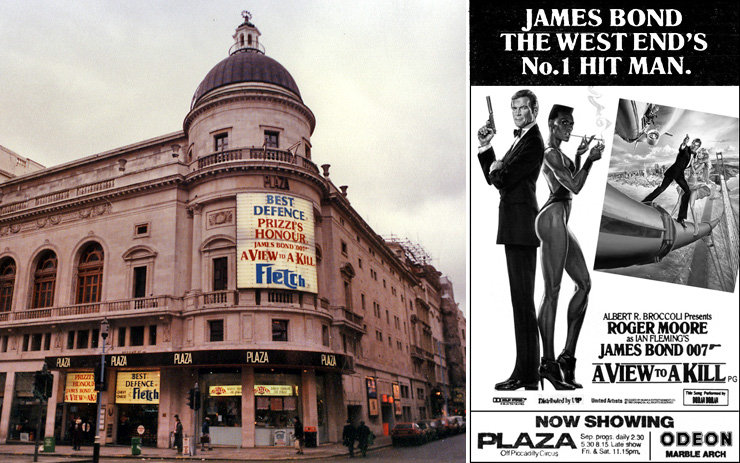 |
|||||||||||
|
With many cinemas now converted to multi-screen venues, A View To A Kill also played for 18-weeks at the Plaza cinema, Piccadilly Circus from Friday September 27, 1985. For the first two-weeks A View To A Kill screened at the Plaza 1, followed by three-weeks at the 183-seat Plaza 4, and a further thirteen-weeks at the 163-seat Plaza 3. The general release of Roger Moore's last James Bond film began in major cities on Friday June 14, and selected coastal resorts from Friday July 5; with a London-wide release from Friday July 19, 1985. As had been the case with You Only Live Twice (1967), Live And Let Die (1973) and The Spy Who Loved Me (1977), the general release of A View To A Kill was timed to coincide with the school summer holidays, and its box-office success was boosted by unusually poor weather that year, forcing many people off the beaches and into the cinema. Despite the success of A View To A Kill at the box-office, many thought that aged 58 its star was far too old to continue playing James Bond, and the films were becoming increasingly comedic and far-fetched because of it. This was an opinion shared by Roger Moore, who formally announced his retirement from the role of James Bond on December 3, 1985. |
|||||||||||
|
|||||||||||
|
“The new James Bond...
living on the edge” |
|||||||||||
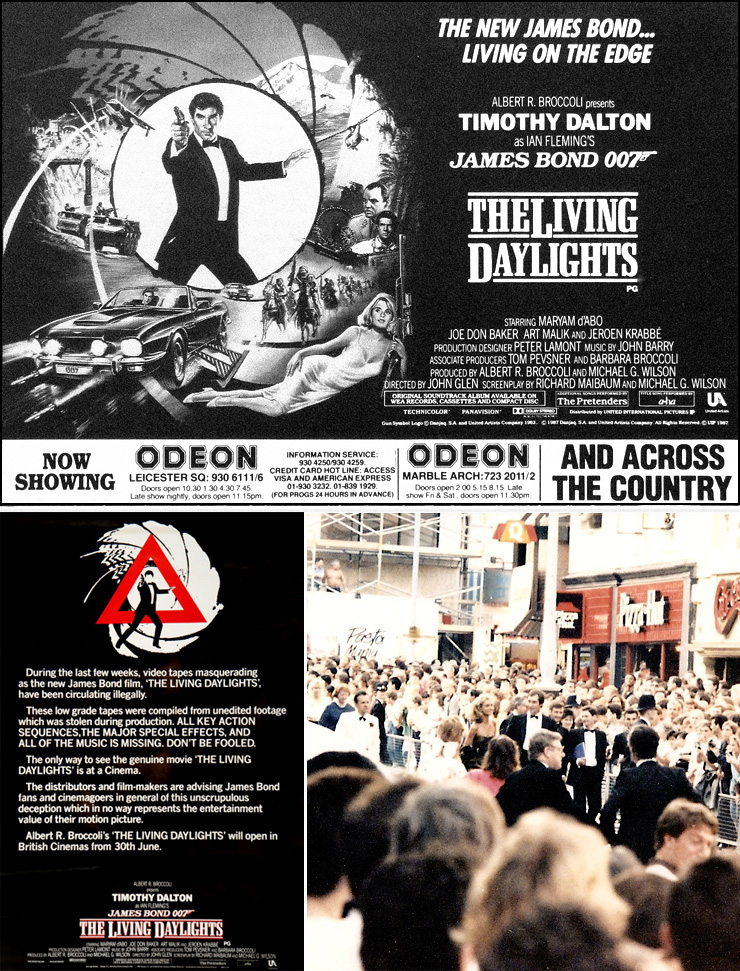 |
|||||||||||
|
Timothy Dalton's debut as James Bond was first screened in London for the press on the morning of Monday June 29, 1987, at the Leicester Square Theatre. As the reviewers and critics watched the film, 100-yards away the ODEON Leicester Square was being prepared for that evening's Royal World Charity Premiere. Leicester Square itself was renamed ‘James Bond Square’ for the day, and huge crowds gathered outside the ODEON to watch contractors erect the huge exterior hoarding featuring the colourful poster artwork centred around the iconic gun barrel motif designed by Maurice Binder. The Aston Martin V8 Volante from the film was also on display in the square throughout the day, and Director John Glen chatted with fans as the preparations for that evening's Premiere began. Press reviews were generally very enthusiastic and highlighted the return to a ‘classic’ Bond film, with little of the humour and excess associated with the series in the latter years. |
|||||||||||
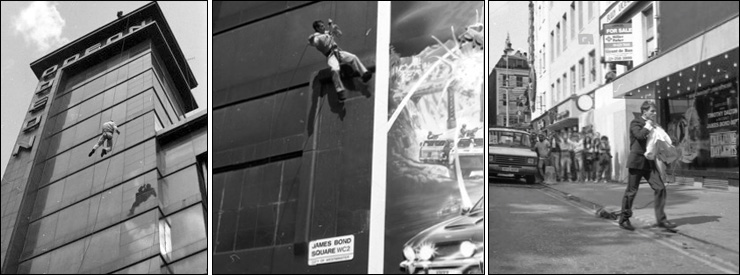 |
|||||||||||
|
From the moment Timothy Dalton walked through Leicester Square accompanied by co-star Maryam d'Abo he was James Bond, and the assembled crowds enthusiastically applauded and cheered as he made his way to the Premiere. Stuntman Simon Crane dressed as James Bond [pictured above] abseiled from the top of the 120-foot high ODEON tower before making his was into the cinema, much to the delight of the onlookers gathered in Leicester Square to watch celebrities arriving at the Premiere. |
|||||||||||
|
|||||||||||
|
The Royal World Charity Premiere was once again held in the presence of Their Royal Highnesses The Prince and Princess of Wales, and also attended by Producer Albert R. Broccoli accompanied by his wife Dana, co-producer (and co-screenwriter) Michael G. Wilson, actors Joe Don Baker, Jeroen Krabbé, Caroline Bliss, Art Malik, Julie T. Wallace, Geoffrey Keen, Walter Gotell and Andreas Wisniewski, composer John Barry (whose last Bond score this would be), and Chrissie Hynde of The Pretenders who sang ‘Where Has Everybody Gone?’, and ‘If There Was A Man’ in the film. Also attending the Premiere was James Bond continuation author John Gardner, whose sixth 007 novel NO DEALS MR. BOND had been published a month earlier. John Gardner was also invited to the after-Premiere party held at the Inner Temple Hall on London's Victoria Embankment. Patrick Macnee, star of The Avengers TV series, who had played Sir Godfrey Tibbett in A View To A Kill (1985), and Fiona Fullerton (who played Pola Ivanova in A View To A Kill) also attended the Premiere of The Living Daylights. |
|||||||||||
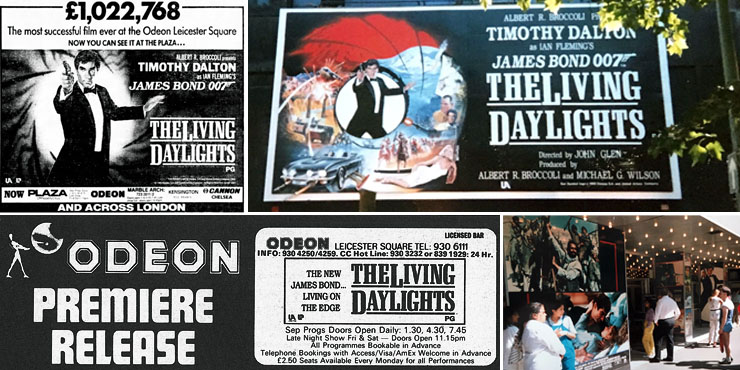 |
|||||||||||
|
The James Bond series celebrated its 25th Anniversary in style, and The Living Daylights then opened to the public at the ODEON Leicester Square and ODEON Marble Arch [pictured below right] on Tuesday June 30, 1987, and across the country throughout July. In the three days following the Premiere, The Living Daylights grossed £52,656 in Leicester Square and £13,049 at the ODEON Marble Arch. The Living Daylights ultimately became the most successful film ever to play at the ODEON Leicester Square, and grossed a staggering £1,022,768 over its 11-week run. |
|||||||||||
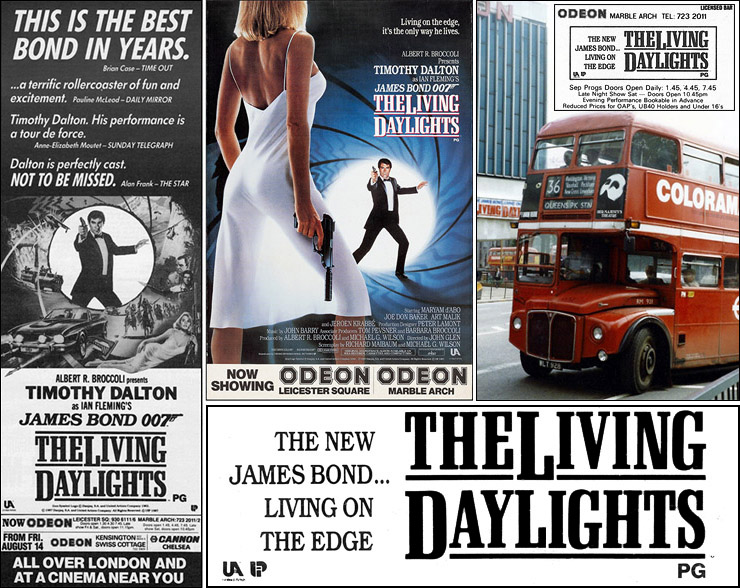 |
|||||||||||
|
The Living Daylights then transferred to the Plaza 1, off Piccadilly Circus from Friday September 11, 1987, where it played for a further four-weeks. On Friday October 9, 1987, The Living Daylights also opened at the 304-seat Empire 2, Leicester Square where it played for seven-weeks; and then transferred to the smaller 80-seat Empire 3 for a further eleven-weeks, finishing its West End run on Thursday February 11, 1988. The Empire was another larger cinema which had been converted into a multi-screen venue in 1985, and incorporated part of the old Ritz cinema into its new configuration. Timothy Dalton's debut as 007 became the most successful film released in the UK in 1987, taking £5.5-million at the box-office. |
|||||||||||
 |
|||||||||||
|
|
|||||||||||